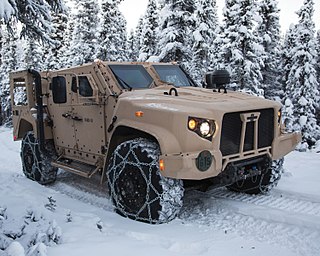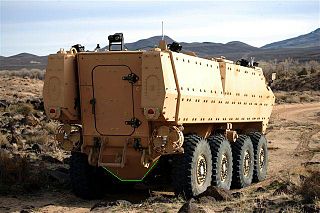
The High Mobility Multipurpose Wheeled Vehicle is a family of light, four-wheel drive military trucks and utility vehicles produced by AM General. It has largely supplanted the roles previously performed by the original jeep, and others such as the Vietnam War-era M151 Jeep, the M561 "Gama Goat", their M718A1 and M792 ambulance versions, the Commercial Utility Cargo Vehicle, and other light trucks. Primarily used by the United States military, it is also used by numerous other countries and organizations and even in civilian adaptations.

Military vehicles are commonly armoured to withstand the impact of shrapnel, bullets, shells, rockets, and missiles, protecting the personnel inside from enemy fire. Such vehicles include armoured fighting vehicles like tanks, aircraft, and ships.

A gun truck is an armored vehicle with one or more crew-served weapons, typically based on a military truck. Gun trucks often have improvised vehicle armor, such as scrap metal, concrete, gravel, or sandbags, which is added to a heavy truck.

The Cougar is a mine-resistant ambush-protected (MRAP) and infantry mobility vehicle structured to be resistant to landmines and improvised munitions.

The RG-33 is a mine-resistant light armored vehicle initially designed by BAE Systems Land Systems South Africa, a South African subsidiary of BAE Systems. BAE Systems in the US extensively modified it with additional protection, new powertrain, and suspension systems. It was built in a number of locations including York, Pennsylvania. It was one of several vehicles being fielded by the US Armed Forces in Iraq under the MRAP program.

The Joint Light Tactical Vehicle (JLTV) program was a U.S. Army, U.S. Marine Corps and Special Operations Command competition to select a vehicle to partially replace the Humvee fleet with a family of more survivable vehicles having a greater payload. Early studies for the JLTV program were approved in 2006. The JLTV program incorporates lessons learned from the earlier Future Tactical Truck Systems program and other associated efforts.

The International MXT-MV is an infantry mobility vehicle produced by Navistar Defense, a subsidiary of Navistar International, which is the owner of the International brand of vehicles. Introduced in 2006 and developed in parallel with the civilian International MXT, the MXT-MV is extensively modified for military duty compared to its civilian counterpart. It is transportable by the Lockheed C-130 Hercules military aircraft.

The Medium Mine Protected Vehicle (MMPV) is a class of armored vehicles being procured by the US Army, similar to the MRAP program, which is being pursued by the US Army and the US Marine Corps.

The International M1224 MaxxPro MRAP is an armored fighting vehicle designed by American company Navistar International's subsidiary Navistar Defense along with the Israeli Plasan Sasa, who designed and manufactures the vehicle's armor. The vehicle was designed to take part in the US military's Mine Resistant Ambush Protected vehicle program, led by the US Marine Corps, as well as a similar US Army-led Medium Mine Protected Vehicle program.
The Bull is an armored personnel carrier with a v-shaped hull designed in a combined effort between Ceradyne, Ideal Innovations Inc. (I-3), and Oshkosh Corporation in response to the MRAP II competition. "The Bull" is a trade-mark of Ideal Innovations, Inc. (I-3).

The V-hull is a type of vehicle armor design used on wheeled armored personnel carriers (APCs), infantry mobility vehicles, infantry fighting vehicles (IFVs) and MRAPs. The design originated in the 1970s with vehicles such as the Casspir used extensively during the South African Border War, Leopard security vehicle used in the Rhodesian Bush War and South African armored vehicle company Land Systems OMCs and Buffels.

The Humvee replacement process was an effort by the U.S. military to replace the current AM General Humvee multi-purpose motor vehicle. The Humvee had evolved several times since its introduction in 1985, and is now used in tactical roles for which it was not originally intended. The U.S. military pursued several initiatives to replace it, both in the short and long term. The short-term replacement efforts utilize commercial off-the-shelf (COTS) vehicles, while the long-term efforts focused on building requirements for the Humvee replacement and technology research and evaluation in the form of various prototype vehicles.

The Oshkosh M-ATV is a mine-resistant ambush protected (MRAP) vehicle developed by the Oshkosh Corporation for the MRAP All Terrain Vehicle (M-ATV) program. Intended to replace M1114 HMMWVs (Humvee), it is designed to provide the same levels of protection as the larger and heavier previous MRAPs, but with improved mobility.

The Force Protection Ocelot is a British infantry mobility vehicle that replaced the United Kingdom's Snatch Land Rover with British forces. It received the service name Foxhound, in line with the canine names given to other wheeled armored vehicles in current British use such as Mastiff, Wolfhound, and Ridgeback, which are all variants of the Cougar.

The Q-NET is an add-on armor kit developed by QinetiQ to counter the threat of rocket-propelled grenades.

The Oshkosh Alpha is a Mine-Resistant Ambush Protected (MRAP) vehicle created by Oshkosh Corporation together with Protected Vehicles Incorporated (PVI). It is considered as a Category I MRAP vehicle.
The Armor Survivability Kit (ASK) is an armor kit developed by the U.S. Army Research Laboratory (ARL) in 2003 to protect vehicles like the Humvee from small arms, explosive device fragments, and rocket-propelled grenades (RPGs).
U.S. Army Research Laboratory (ARL) research on MRAP Armor Weight Reduction Spiral (MAWRS) program resulted in armor technologies 40 percent lighter, with technologies fielded on more than 10,000 MRAP vehicles. Dozens of spin-out designs were provided to most major combat and tactical wheeled-vehicles program in production.

United States MRAP program was created to produce Mine-Resistant Ambush Protected Vehicle for the country. In 2004, the TSG/FPI Cougar was designed by a British-led U.S. team, to U.S. Marine Corps requirements. It became the springboard from which the MRAP program was launched. Only two "armor quality" steel mills operate in the U.S.: the Russian-owned Oregon Steel Mills and the International Steel Group. The U.S. Department of Defense negotiated to ensure enough steel was available to keep pace with production. The U.S. military's MRAP program was prompted by U.S. casualties from improvised explosive devices (IED)s during the Iraq War. The United States Department of Defense MRAP program began in 2007 as a response to the increased threat of IEDs during the Iraq War. From 2007 until 2012, the MRAP program deployed more than 12,000 vehicles in the Iraq War and War in Afghanistan.
















